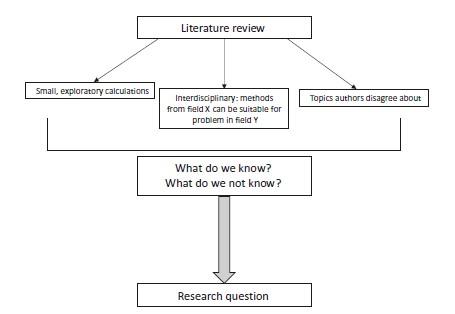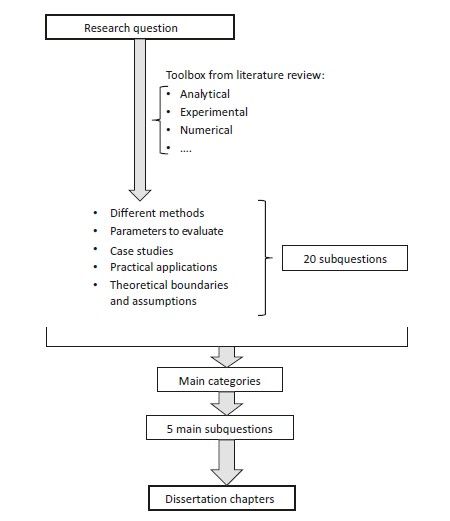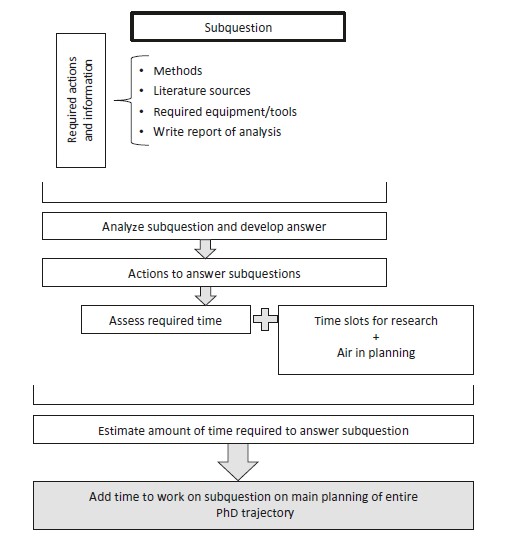Ini adalah lanjutan dari tulisan sebelumnya, Developing Your Literature Review, oleh Lantsoght (2018) dalam bukunya The A-Z of the PhD Trajectory A Practical Guide for a Successful Journey.
From Literature Review (LR) to Research Question (RQ)
1. From LR to RQ
A. Identifying gaps in the knowledge
When you have read broadly and deeply in your field and tangentially related fields, you will start to see the open opportunities.
 (Sumber gambar : Lantsoght [2018])
(Sumber gambar : Lantsoght [2018])
Your RQ is not something you write one morning after a God-sent dream. It’s the result of reading, thinking about what you read, and discussing these thoughts with your peers and supervisor.
It’s a highly iterative procedure, and often your RQ gets molded and shaped along your PhD trajectory.
While reading the literature, there are a number of different “empty spots” you can identify.
Here are a few examples to get your started :
(1) Case where the boundary conditions of the usually applied theories are not valid anymore
(2) In experimental work : parameters that have not been tested
(3) Applying methods from “field X” to problem in “field Y”
(4) Application of new materials and new technologies
(5) Computational analysis and simulation of physical phenomena
If you think you have an idea for your RQ, prepare “a short document” outlining the gaps you found in the literature, or the open options to explore that you identified from your LR.
(1) Briefly discuss the key references, and how you see your first idea of a RQ framed inside the literature.
(2) Have “something on paper” to discuss with your supervisor, and show him the main references on which you plan to base your work -> ini lebih baik dari sekedar “saya punya ide tentang a, b, c, d, … “ -> harus ada “sufficient background and depth on the how and way of coming to your first idea of a RQ”
There are a number of “technical requirement” your RQ needs to fulfil, for it to actually be a RQ :
(1) Your RQ should be specific
(2) Your RQ should have its limits
(3) Your RQ should not show bias or an opinion
B. Self-Assessing your RQ
Use the following criteria:
(1) Originality
You have to develop work that has not been done before.
This does not mean you have to reinvent the wheel, but it means that you need to find your little corner of interest and knowledge in your field, and make a novel contribution inside that little corner.
(2) Practically
Do you have an idea og the methods that you want to use to investigate your RQ?
Are these methods possible from a practical point of view?
(3) Feasibility
Can you finish it within the required time?
(4) Ethics
C. Creative thinking
Scientific research is an extended endeavor of creativity. One the key elements to creative thinking is to learn to ask yourself questions. Questions are the best tool for actually pointing out a lack in our knowledge.
When carrying out your LR, it is important to ask yourself why certain assumptions are at the basis of a theory, and if this assumptions are always valid.
The reason why qustions are so quintessential to creative thinking:
(1) Mindset: open, inquirring mind, asking questions along the way, without feeling pressure to perform
(2) Breaking down a problem: pecah menjadi subquestions sehingga menjadi lebih spesifik. Start by solving your subquestion and use this information as building blocks to solve your main RQ
(3) Identifying key points: catat poin penting dan pelajari lebih dalam
Feynman bilang : “You don’t need the perfect conditions to do creative work.”
Here are the ingredients to create optimal conditions for creative work :
(1) Scheduled time: jadwalkan waktu kerjamu
(2) Comfort: suasana nyaman, bersih
(3) Mindset: keep that open and inquirring mind
Creativity is a skill. You are not born creative or not.
2. Putting Your RQ to Action
A. From RQ to Subquestions
Your subquestions identify the next actions you need to take. Each subquestion should be something for which you will select one method to solve it. A subquestion should not involve more than one method.
 (Sumber gambar : Lantsoght [2018])
(Sumber gambar : Lantsoght [2018])
B. From Reseach Subquestions to Dissertation Chapters
Your main subquestions, which bring together a number of smaller questions and ideas of methods, become your “dissertation chapters”.
C. From Reseach Subquestions to Actions and Planning
Start with the first small question, and list all the actions you need to undertake to answer it.
Schedule time for these actions.
 (Sumber gambar : Lantsoght [2018])
(Sumber gambar : Lantsoght [2018])
————–
Muhammad Fauzan
Selasa, 31 Januari 2023 (22.03 WIB)

